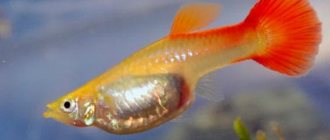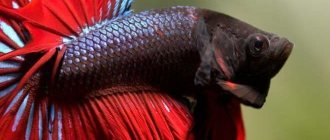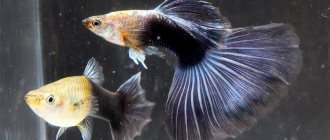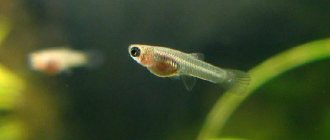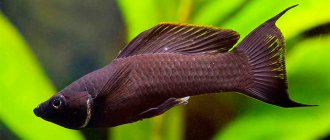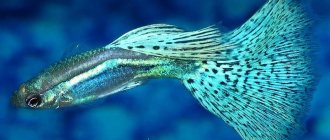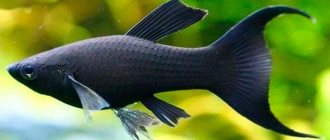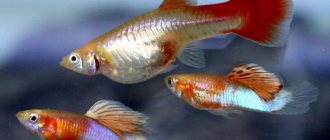As soon as the eggs hatch, you are just beginning your journey in fish breeding and raising fry. After all, raising a fry is often a more difficult task than getting a couple to spawn, and getting eggs is only half the battle.
On the one hand, most cichlids and viviparous fish give birth to fry large enough to immediately begin feeding on artificial food, but the majority of aquarium fish, such as pearl gouramis, laliuses, cardinals, and marcropods, give birth to very small fry that need to be fed with the same small food.
Their fry are so small that they themselves could serve as food for a guppy or cichlid fry.
Also, juveniles can only eat food that moves and you will have very little time to train them to eat other foods before they begin to die of hunger.
Next, we will look at the many different foods that aquarists use to feed their fry. Each of them is quite nutritious on its own, but it is better to use several different ones to create a complete diet.
Specifics of nutrition of live-born fry
Guppies are viviparous fish. The fry are formed in the mother's abdomen and after birth are her exact small copies. They have a mouth, and they literally immediately begin to use it for food.
The fry are born as fully formed small fish.
Just what to feed the guppy fry is not allowed. They need a balanced diet that contains everything their body needs to thrive. The quality of feeding determines whether they will grow into beautiful and healthy adult fish. Food for guppy fry is finely ground into pollen. They have very small mouths and cannot swallow as large pieces of food as adults.
Guppies are guilty of cannibalism. Females lack maternal instinct and love to eat their young.
Baby guppies instinctively hide in the bushes after they are born.
Fry need to be fed differently than adult fish:
- First of all, more often. Newborn guppies eat up to six times a day, while grown-ups need only two meals a day.
- Secondly, in portions. You can’t pour out food for future use. The excess will settle to the bottom and nitrogen will form in the water. If there is a lot of it, the brood will die. Feed the fry in portions that they can eat at a time. Or wait until they are full and immediately remove the leftovers from the meal.
- Thirdly, more abundantly. Until two weeks of age, fry should be given food in an amount approximately 1.5 times their own weight. And then until two months - 2 times. Only by the sixtieth day can they be transferred to moderate feeding - 15–30% of body weight.
The main causes of death of fry in an aquarium and methods for eliminating them
Of course, when breeding aquarium fish, loss of offspring is not excluded. This may be due not only to the inexperience of the owner, but also to a number of other reasons:
- The most common cause of death of fry is banal underfeeding.
Newborn fish need food in the first hours; if this time is missed, they may die. To avoid this, you must always have a small supply of food for the fry on hand; - poor quality or expired food.
This reason follows from the previous one, many people purchase food without paying attention to expiration dates, which results in poisoning of young animals; - overpopulation of the aquarium.
Many fish die in the first hours or days as a result of poisoning from water contaminated with waste products of their relatives and food residues. In order to avoid this situation, you need to place the females in advance to lay eggs in a separate aquarium or transplant pregnant livebearers into it, as well as regularly clean and change the water and rinse the plants.
Important!
When feeding young animals with “adult” food, try to grind it thoroughly, since fry often die due to an attempt to swallow too large particles of food.
We looked at the main stages of breeding aquarium fish fry and the features of caring for them. This is an important and responsible process that requires attention and time, but if simple rules are followed, it will not bring excessive trouble to the owner and very soon the new grown-up individuals will delight the eye in the common aquarium.
What is needed in the first days
When the fry are born, they still continue to feed from the yolk sac. But its contents will last for a maximum of a couple of hours. Therefore, start feeding your guppies immediately after birth.
From this moment until the seventh day, give them live dust and finely ground boiled yolks diluted with water. Live dust is small live food - slipper ciliates, rotifers, microworms, Artemia nauplii. You can buy it at a pet store or breed it yourself.
Guppy fry wait for their first feeding within a few hours after birth.
Feeding should be frequent - 5 to 7 times a day. Maintain equal intervals between meals . Make sure that the fry always have rounded bellies. This means they are full. Don't forget to monitor the water temperature. In the first days, the optimal temperature is 28 °C. Then it is gradually reduced every week by 2 °C to 24 °C.
Daylight hours for guppy fry less than a week old should last at least 20 hours.
Reviews
If you really want to breed guppies but can’t buy a second aquarium, you can keep the fry in a jar and, after they grow up, put them in a general aquarium.
It has been noticed that when the fry grows to a size of approx. 1.5 cm small “peaceful” fish no longer see food in it. One 3 liter jar can hold approx. 20 fry. Always with a sprig of hornwort, two small ampularia. Without aeration but with lighting sufficient for plant growth. At the very beginning you can feed with crushed dry daphnia, after a few days they will be able to eat small bloodworms. It must be taken into account that the fry grow quickly, begin to reproduce and eventually the guppies just fill the tank. Sealor
https://www.aquaforum.ua/showpost.php?p=26358&postcount=5
Was this article helpful?
Yes
No
Nutrition of grown fry
Teenage guppies are less picky eaters and happily swallow whatever fits into their small mouths. From days 7 to 50, you can feed them commercial dry formula. However, it is better to offer your guppies high-quality live food. On it they will grow faster and acquire a beautiful bright color.
Artemia nauplii, crushed bloodworms, nematodes and tubifex worms are suitable. You can also cook homemade food.
For older fry, feeding three times a day is enough. The duration of daylight hours can also be reduced to 12 hours.
At 60 days, guppies are considered adults. At this age, you can gradually transfer them to the same diet as the rest of the fish in an adult aquarium.
Daphnia
Daphnia
Food in the form of daphnia must be purchased exclusively under proven conditions, because it is very difficult to disinfect. You should also remember that if you decide to breed daphnia yourself, then the “initial” material should also be purchased from trusted places, since nutrition threatens the formation of various diseases. To breed daphnia yourself for feeding aquarium fish fry, you need to purchase a large plastic container of about 20 liters. Pour water into it and let it sit at room temperature for 48 hours. This food must be cultivated with a handful of fertilizers. Moreover, you will need a nylon bag (in this case, you can also use a pair of nylon stockings). You should put fertilizer there and lower this bag into water. In the period from 7 to 10 days, a colony of microorganisms on which daphnia feeds will appear in the water. Feeding guppy fry with daphnia can be done by simply pulling it out of the barrel using a net.
Live food
These include any organisms that are included in the natural diet of fry in their natural habitat. These are tubifex, bloodworms, cortemia, daphnia, coretras, aulophorus, rotifers, cyclops. Although they are of natural origin and are present in abundance in ponds, it is not advisable to catch them yourself. There is a risk that wild crops are infected. In addition, along with them, you can bring larvae or even adult predatory insects into the aquarium and ruin the entire population of young fish.
Freezing is a good alternative to drying when it comes to storing food.
Some types of live food are easy to grow at home. These are small daphnia, aulophorus, nematodes, grindal, microworms. Example of microworm breeding:
- mix corn flour and water in such a ratio to obtain a creamy mass, and add yeast to it;
- insert a microworm into the resulting nutrient medium and wait - in a few days it will give birth.
You can buy frozen live food. These are the same daphnia, tubifex, aulophorus and other crops. But they contain fewer beneficial microelements, so use them only if you cannot find an alternative.
For self-breeding, start several crops at once, since it is rarely possible to get a lot of food from one. This way you can alternate them, and your fry will always be full.
Let's see who was caught
Everything that is caught in the net must be carefully examined. Strain all live food through a net or fine sieve and transfer to clean water. Take a good look and if you notice something you don’t know, don’t give it to the fry. Among the safe organisms there may be those that can harm not only fry, but also adult fish, for example, hydra and planaria.
Hydra
Planarians
Cyclops crustacean
For the smallest fry of spawning fish, it is advisable to exclude the Cyclops crustacean. In most cases, live food for fry caught where there are no fish does not require additional processing.
Home Recipes
A good protein food can be prepared from ordinary products. Let's look at several recipes for hearty and balanced homemade food for fry.
Boiled egg
Boil a chicken egg, remove the yolk and crumble it with a fork. Then dilute with a small amount of aquarium water and drop it into the vessel with the fry from a pipette. You can put the yolk in a piece of gauze, lower it into the container with the guppy and stir it so that egg dust sprinkles - this will become food for the young. Keep in mind that such complementary foods quickly spoil the water. If you use it, change the water more often than usual.
Curdled milk
Pour boiling water over it. The casein (protein) will coagulate and form a curd. Catch it with a net with small holes and rinse it well to remove the whey. Feed the fish from a net by shaking it over the water. The smallest particles of food will fall onto the surface of the water. Unlike yolk, curdled milk does not pollute the aquarium environment as actively.
Powdered milk
Pour fresh into a plate and place it on a container of boiling water. Stirring regularly, evaporate the liquid. The resulting powder can not dissolve in water for hours, during which time it is completely eaten by the fry. When buying ready-made powdered milk in a store, pay attention to the composition, which should not contain anything unnecessary!
Omelette
Beat 2 eggs into the pan, add 2 tsp. nettle or oatmeal and, stirring continuously, pour in 100 ml of boiling milk. When the egg has curled, remove it from the heat and cool. Chop before serving to the fry.
Cheese
Take natural hard cheese, grate it on the finest grater and dry it if necessary. Add it to the water a little at a time, as it quickly spoils it.
Food prepared at home can only be given to fry as a supplement to the diet . It cannot become a complete food for them, since it does not provide them with all the required nutrients.
Newborn guppies must receive phytoplankton, algae and other components of plant origin. It is important to feed them with chopped live food.
On store shelves
There are many different dry foods in pet stores designed specifically for fry. They differ from mixtures for adult fish in their increased protein content and greater degree of grinding. There are options from small granules to powders.
Introduce the fry to dry food gradually. At first, give them as complementary food in addition to live and frozen cultures, and just before moving them into an adult aquarium, switch to them completely.
The main advantage of purchased food is its balance, which is very difficult to achieve on a natural diet. Manufacturers enrich them with vitamins, minerals, calcium fluoride and other nutrients important for the full growth and development of guppy fry.
The following brands of dry food are popular among aquarists:
- MikroMin,
- JBL,
- SERA,
- Tetra.
Summary
Guppy fry begin to be fed immediately after birth. Over the course of 7 days, 5-7 times, in subsequent days - 3-4 times. At first they are given only live dust and finely ground chicken yolks. Then - live and homemade food. At two months of age, the fry are returned to the parent aquarium. As they approach this date, they need to gradually switch them to dry food, which is what other adult fish eat.
The little guppies don't look like their parents and are almost transparent!
There is no ideal universal food for guppy fry. They are all good and bad in their own way. The main rules that should be followed in feeding them are systematicity, balance and moderation.
Types of food
You need to fry often and quite a lot. Some aquarists do not turn off the lighting in the aquarium where the fry are located for several days and organize dosed feeding every 3-4 hours.
There are two main approaches to the issue of food choice.
- Some guppy owners successfully raise their pets using natural food (protein and plant foods).
- But there are also adherents of branded starter feeds.
It is difficult to say unequivocally which method is better, but it is important that the diet is balanced. Without overfeeding, of course.
